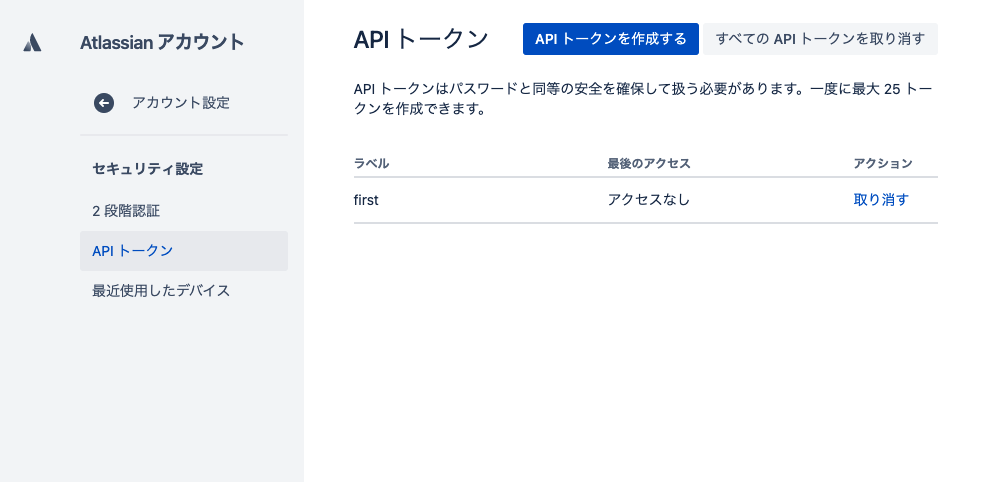今回 Confluence API を触ることがあったけど、日本語のドキュメントがなかったのと、
トークンの取得->API 叩くまでのフローが体型的にまとまってない & 公式ドキュメントがわかりづらかったので、今回自己流にまとめる。
またドキュメントに載っていない情報もあるので、それもまとめる
ただ、自分は Confluence 自体を触ることがほとんどないので、あんまりニーズとマッチしないかも
基本的な oauth フローや oauth で取得したトークンを利用した API リクエストの方法については説明しません。
具体的には、以下の内容を扱います。
- Confluence の設定画面に行く

- パスワード

- セキュリティ)API トークン

- API トークンの作成するボタンからトークンを作成できる
- ディベロッパーコンソールにアクセスします。https://developer.atlassian.com/console
- Create ボタン > OAuth 2.0 integration から Confluence アプリを作成できます
- 次にスコープを設定します。アプリの管理画面 > Permisisons > Confluence API Add/Configure > Edit scope から編集します。
- スコープの詳細はここから確認できます。必要なスコープを設定してください。https://developer.atlassian.com/cloud/confluence/scopes-for-oauth-2-3LO-and-forge-apps/
- Oauth トークンの取得は、Jira での公式の例を流用して行えます。 https://github.com/atlassian-api/atlassian-python-api/blob/master/examples/jira/jira_oauth2.py
from requests_oauthlib import OAuth2Session
from atlassian import Confluence
from flask import Flask, request, redirect, session
import requests
app = Flask(__name__)
app.secret_key = ""
# JIRA OAuth URLs
authorization_base_url = "https://auth.atlassian.com/authorize"
token_url = "https://auth.atlassian.com/oauth/token"
client_id = "{client_id}"
client_secret = "{client_secret}"
redirect_uri = "{callback}"
@app.route("/login")
def login():
scope = ["read:page:confluence","read:attachment:confluence","read:blogpost:confluence",
"read:custom-content:confluence","read:comment:confluence","read:group:confluence",
"read:configuration:confluence","read:space:confluence","read:space.permission:confluence",
"read:space.property:confluence","read:space.setting:confluence","read:content.permission:confluence",
"read:content.property:confluence","read:content.restriction:confluence","read:content.metadata:confluence",
"read:content-details:confluence", "read:space-details:confluence",
"read:user:confluence", "read:space:confluence", "offline_access"]
audience = "api.atlassian.com"
oauth = OAuth2Session(client_id, scope=scope, redirect_uri=redirect_uri)
authorization_url, state = oauth.authorization_url(
authorization_base_url,
audience=audience,
)
session["oauth_state"] = state
return redirect(authorization_url)
@app.route("/callback")
def callback():
jira_oauth = OAuth2Session(client_id, state=session["oauth_state"], redirect_uri=redirect_uri)
token_json = jira_oauth.fetch_token(token_url, client_secret=client_secret, authorization_response=request.url)
with open("token.json", "w") as f:
f.write(str(token_json).replace("'", '"'))
# return "Token: {}<p />Projects: {}".format(token_json, ", ".join(get_projects(token_json)))
return "Token: {}<p />".format(token_json)
def get_projects(token_json):
req = requests.get(
"https://api.atlassian.com/oauth/token/accessible-resources",
headers={
"Authorization": "Bearer {}".format(token_json["access_token"]),
"Accept": "application/json",
},
)
req.raise_for_status()
resources = req.json()
cloud_id = resources[0]["id"]
oauth2_dict = {
"client_id": client_id,
"token": {
"access_token": token_json["access_token"],
"token_type": "Bearer",
},
}
jira = Jira(url="https://api.atlassian.com/ex/jira/{}".format(cloud_id), oauth2=oauth2_dict)
return [project["name"] for project in jira.projects()]
app.secret_key = "{secret_key}"
app.run(host="localhost", port=8080, ssl_context=('crt_path', 'key_path'), threaded=True, debug=True)
以降の api へのリクエストはここで取得した token を使って行います。
ここで注意して欲しいのは、取得したトークンの有効期限は 1 時間です。
1時間後に有効期限が切れてしまいます。
1時間後にはトークンの再取得か、 期限が切れたトークンの refresh が必要です。
公式ドキュメント・詳細はこちらにあります。 https://developer.atlassian.com/cloud/confluence/oauth-2-3lo-apps/#faq1
トークンの更新のために、offline_access を追加します。
これは、アプリ管理画面のスコープ管理にはないので、Oauth 認証フローの scope に追加します。
これを追加することで、トークンと同時にrefresh tokenが取得できます。
このrefresh tokenを使って、新たに認証し直さなくても新しくトークンを取得できます。
具体的には、以下のエンドポイントを叩くと、新しいトークンと、新しい refresh token、有効時間等の情報が返ってきます。
curl --request POST \
--url 'https://auth.atlassian.com/oauth/token' \
--header 'Content-Type: application/json' \
--data '{ "grant_type": "refresh_token", "client_id": "YOUR_CLIENT_ID", "client_secret": "YOUR_CLIENT_SECRET", "refresh_token": "YOUR_REFRESH_TOKEN" }'
あと一歩で実際に API 叩いて記事を取得できます!
公式ドキュメントはこちらです。https://developer.atlassian.com/cloud/confluence/oauth-2-3lo-apps/#3--make-calls-to-the-api-using-the-access-token
最後にステップは cloud id の取得です。
こんな感じで cloud id を取得できます。
curl --request GET \
--url https://api.atlassian.com/oauth/token/accessible-resources \
--header 'Authorization: Bearer ACCESS_TOKEN' \
--header 'Accept: application/json'
この cloud id を使って、api 叩くための url を作ります。
では実際に記事を取得してみます。 公式ドキュメント: https://developer.atlassian.com/cloud/confluence/rest/api-group-content/#api-wiki-rest-api-content-get
公式の exapmle をちょっと変えています。
# This code sample uses the 'requests' library:
# http://docs.python-requests.org
import requests
import json
cloud_id = "取得したcloud_id"
# url = "https://your-domain.atlassian.net/wiki/rest/api/content"
url = "https://api.atlassian.com/ex/confluence/{cloud_id}/rest/api/content"
headers = {
"Accept": "application/json",
"Authorization": "Bearer <access_token>"
}
response = requests.request(
"GET",
url,
headers=headers
)
print(json.dumps(json.loads(response.text), sort_keys=True, indent=4, separators=(",", ": ")))
公式ドキュメントだと url が"https://your-domain.atlassian.net/wiki/rest/api/content"となっていますが、
your-domain を置き換えても"Unauthorized"になって終わります。
実際には cloud id を使って、上記のように url を作り、api 叩きます。
url 以外はドキュメントと同じです。
この例で、page が取得できます(blogpost は別)
上記の API を叩いた方、気づいたと思いますが、記事の本文やコメント等の情報が取得できていません。
これは、別に指定する必要があります。
指定は expand パラメータを指定することで行います。
例えば、記事の本文を取得する際、次のような url が必要になります
url = "https://api.atlassian.com/ex/confluence/{cloud_id}/rest/api/content?expand=body.storage,body.view"
このように、expand は複数指定でき、カンマでくぎります。(公式ドキュメント: https://developer.atlassian.com/server/confluence/expansions-in-the-rest-api/)
本文は複数のフォーマットがあって、細かいことは調べていないんですが、storage の方がサイズが小さく、view は html タグとかそのままの状態という雰囲気でした。
同様に、コメントも同時に取得したい時は次のようになります。
url = "https://api.atlassian.com/ex/confluence/{cloud_id}/rest/api/content?expand=body.storage,body.view,comment.body.storage"
公式ドキュメントには書かれていない?っぽいですが、コメントも body 以下と同じような expand があるようで、コメント本文の取得には comment.body.storage(comment.body.view)が必要になります。
ページネーションは、クエリパラメータの start で管理されているようです。 また、直接次にアクセスすべきリンクも送ってくれています。 リクエストに成功した時、まだページがある場合、次の位置にあるリンクを叩くと、続きを貰えます。
{
"_links": {
"next": "リンク"
}
}
簡易な python confluence api クライアント書いたので載せときます。ご参考になれば。 https://gist.github.com/argonism/2a32691c1356526e6b892815c35f54da#file-confluence_api_client-py